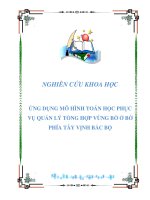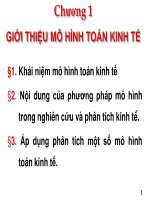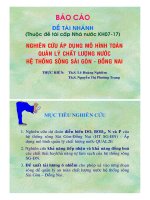Câu hỏi GIS, viễn thám, mô hình toán
Bạn đang xem bản rút gọn của tài liệu. Xem và tải ngay bản đầy đủ của tài liệu tại đây (1.85 MB, 36 trang )
<span class='text_page_counter'>(1)</span>Use of SWAT to Scale Sediment Delivery from Field to Watershed in an Agricultural Landscape with Depressions James E. Almendinger St. Croix Watershed Research Station, Science Museum of Minnesota. Marylee S. Murphy Three Rivers Park District, Minneapolis, Minnesota. Jason S. Ulrich Dept. of Bioproducts and Biosystems Engineering, University of Minnesota.
<span class='text_page_counter'>(2)</span> Outline: . Problem – Landscape depressions impact sediment yield – Sediment Delivery Ratio (SDR) exemplifies this effect. . Solution (partial) – SWAT pond & wetland functions can help – Applied to two watersheds in north-central USA. . Spatial scales of sediment yield – Plot > Field > Upland > Pre-Riverine > Riverine > Watershed. . Conclusion – Extrapolation of plot-scale parameters to the watershed scale requires caution.
<span class='text_page_counter'>(3)</span> Importance: Nonpoint-source pollution (NPS) is the main cause of water pollution in the USA today Landscape depressions – especially noncontributing basins – must have a significant impact on watershed hydrology and transport of NPS (sediment and nutrients) Yet the impact of such depressions is underreported in the literature, especially in the modeling literature. – The research group at Kiel University is an exception. . For sediment transport, landscape depressions contribute to the problem of a scale mis-match – between mechanism at the plot scale, and – impacts at the watershed scale – because depressions are at a scale intermediate between plots and watersheds..
<span class='text_page_counter'>(4)</span> The Problem: often. Plot-scale yields (t km-2 yr-1). >. Watershed-scale yields (t km-2 yr-1). ...and the difference can be LARGE.
<span class='text_page_counter'>(5)</span> Sediment delivery ratio (SDR):. (for yields in t km-2 yr-1). SDR =. SDR =. Watershed sediment yield USLE sediment yield (area wtd). almost always. <<. 1. (or 100%).
<span class='text_page_counter'>(6)</span> SDR is scale-dependent: The larger the watershed, the smaller the SDR.. Maidment, D.R., ed. 1993. Handbook of Hydrology, McGraw Hill, p. 12.53. For 700 km2 watershed, SDR = 6% So 94% of the sediment gets trapped between the field and watershed outlet. Where does it go?? The modeler must make a decision about this….
<span class='text_page_counter'>(7)</span> Where does the missing sediment go? It is halted in short-term and long-term traps between the point of generation and the watershed outlet. FIELD. In-field potholes Grass waterways Edge of field Ponds Wetlands. Floodplains Reservoirs. WATERSHED OUTLET.
<span class='text_page_counter'>(8)</span> How does SWAT handle the problem? SWAT uses the modified USLE = MUSLE . Modified Universal Soil Loss Equation. . – Williams, 1975 – Replaces the USLE rainfall factor with a runoff factor: – 11.8*(Qvol*qpeak)0.56 These two parameters were determined by fitting the MUSLE to sediment yield data from 18 study watersheds in southern USA.. To the degree that these 18 watersheds represent the topographic sediment traps of your watershed, the MUSLE eliminates the need for a sediment delivery ratio. Watersheds with more internal sediment traps will require more processing than MUSLE alone..
<span class='text_page_counter'>(9)</span> Glaciated landscapes can have “deranged hydrology” with many closed depressions. Extent of ice advance at the last glacial maximum, ca. 20 ka, covering Canada and northern USA (after Dyke et al. 2003).
<span class='text_page_counter'>(10)</span> Glaciated landscape depressions. Kettle lakes and wetlands on moraines. SE part of Sunrise River watershed, Minnesota.
<span class='text_page_counter'>(11)</span> Glaciated landscape depressions. Expansive marshes on sandplains. Central part of Sunrise River watershed, Minnesota.
<span class='text_page_counter'>(12)</span> SWAT can simulate the effect of landscape depressions with its Pothole, Pond, and Wetland functions: HRUs. Pothole Infiltration. Tributary Infiltration. Reach Pond & Wetland Seepage. Reservoir. Seepage -- J.E. Almendinger, St. Croix Watershed Research Station, 2011 --.
<span class='text_page_counter'>(13)</span> If SWAT’s impoundments do not reduce sediment yield enough, what more can you do? The MUSLE equation: sed = 11.8*(Qvol*qpeak)0.56*KUSLE*CUSLE*PUSLE*LSUSLE*CFRG All factors are determined by ArcSWAT from your input data (K, C, LS, and CFRG), or by SWAT during each model run (Q and q), EXCEPT for PUSLE. PUSLE: = Support Practice Factor, intended to account for contour tillage practices, e.g. -- Defaults to 1 -- Can be used simply as a scaling parameter to further reduce sediment yields as needed: 0 < PUSLE < 1.
<span class='text_page_counter'>(14)</span> Willow River, western Wisconsin, USA Sunrise River, eastern Minnesota, USA Located near southern edge of glaciated landscape and northern edge of “corn belt” (area of intensive row-crop agriculture in USA). 2. 1.
<span class='text_page_counter'>(15)</span> Land Cover – Willow River watershed, western Wisconsin -- Many small lakes in northern half of watershed, on moraine -- Large wetlands along river -- Built model using SWAT2000: -- 27 subbasins, 532 HRUs.
<span class='text_page_counter'>(16)</span> Drainage areas to depressions – Willow River watershed -- Drainage areas determined by hand, from topographic maps -- 13% of watershed drained to open-basin depressions -- 29% of watershed drained to closed-basin depressions -- Total = 42%.
<span class='text_page_counter'>(17)</span> Willow River: Calibration sequence for sediment yield Willow River watershed, western Wisconsin Sediment Yield (t/km2/yr) 0. 10. 20. 30. 40. 50. 60. Starting point = 78 t/km2/yr 70. 80. Uncalibrated SWAT (MUSLE) After adding Reservoirs After adding Ponds, Wetlands After reducing USLE_P. Target = 2.2 t/km2/yr. -20.6. -12.4. -42.9 (USLE_P = 0.45). 90.
<span class='text_page_counter'>(18)</span> Land Cover – Sunrise River watershed, eastern Minnesota. -- Many kettle lakes on moraine -- Large marshes along river, especially on sandplain -- Built model using SWAT2005 -- 142 subbasins -- 1642 HRUs.
<span class='text_page_counter'>(19)</span> Drainage areas to depressions – Sunrise River watershed -- Drainage areas determined by using ArcHydro Tools ArcHydro depression analysis: -- Ignored depressions (a) with drainage areas < 1 ha, or (b) runoff-fill depths of < 1 cm (= depression volume / drainage area). -- Drainage areas intersecting channel network (with 50-m buffer) and wetland land use = open-basin -- Remaining drainage areas = closed-basin. -- 16% of watershed drained to open-basin depressions -- 25% of watershed drained to closed-basin depressions -- Total = 41%.
<span class='text_page_counter'>(20)</span> Sunrise River: Calibration sequence for sediment yield Sunrise River watershed, eastern Minnesota Sediment Yield (t/km2/yr) 0. 2. 4. 6. 8. 10. Starting point = 13.5 t/km2/yr 12. 14. Uncalibrated SWAT (MUSLE) After adding Reservoirs. -1.4. After adding Ponds, Wetlands. -2.3. After reducing USLE_P After adding channel scour. -7.9 (USLE_P = 0.40) +3.7. Target = 5.5 t/km2/yr. 16.
<span class='text_page_counter'>(21)</span> Conceptual scales of sediment yield HRUs. PLOT (USLE_based). Pothole Infiltration. Tributary Infiltration. PRE-RIVERINE (after Ponds & Wetlands = HRU & Subbasin yields in SWAT). Reach. MUSLE-based:. BASIC UPLAND (USLE_P = 1). Pond & Wetland Seepage. UPLAND (USLE_P < 1). RIVERINE (ravine erosion, floodplain deposition, channel scour or deposition). Reservoir. WATERSHED (after all Reaches & Reservoirs). Seepage. -- J.E. Almendinger, St. Croix Watershed Research Station, 2011 --.
<span class='text_page_counter'>(22)</span> Apparent Sediment Delivery Ratios at nested conceptual spatial scales. After use of MUSLE After reducing P_USLE to 0.45 After adding Ponds & Wetlands After channel processes (none here) After adding Reservoirs. After use of MUSLE After reducing P_USLE to 0.40. After adding Ponds & Wetlands After adding channel scour After adding Reservoirs. Red dashed line = SDR based on watershed area = 0.41 * A-0.3.
<span class='text_page_counter'>(23)</span> Current problem in SWAT model code: Loss of seepage water HRUs. Pothole Infiltration. Tributary Infiltration. Reach Pond & Wetland. All seepage from Ponds, Wetlands, and Reservoirs is lost from the system. Seepage. Reservoir. Seepage. -- J.E. Almendinger, St. Croix Watershed Research Station, 2011 --.
<span class='text_page_counter'>(24)</span> Summary & Conclusions: . Landscape depressions can reduce watershedscale sediment yields far below USLE yields, and even below MUSLE yields – SWAT can simulate these depressions with its Pothole, Pond, Wetland, and Reservoir functions – These functions provide a pseudo-mechanistic way to simulate why SDR < 1 – Erosion may need further reduction by setting P-USLE < 1. . Sediment yield is impacted by many processes intermediate between the plot scale and watershed scale. – Output from SWAT can be extracted at different scales, from Field > Upland > Pre-Riverine > Riverine > Watershed – Hence parameters derived from plot-scale measurements may not be applicable at the watershed scale. Thank You – Questions?.
<span class='text_page_counter'>(25)</span> (extra slides follow).
<span class='text_page_counter'>(26)</span> Conceptual scales of sediment yields in watersheds Conceptual Scale. Description. SWAT output. PLOT. Gross erosion. USLE or RUSLE. Sediment entrained by runoff minus loss to upland traps outside plot HRU or Subbasin output: MUSLE, PUSLE = 1 No Ponds and Wetlands Sediment entrained by runoff minus loss to other upland traps HRU or Subbasin output: Sediment delivered from UPLAND MUSLE, PUSLE < 1, as uplands to lowlands needed No Ponds and Wetlands Loss to lowland traps (ponds, wetlands) Sediment delivered HRU or Subbasin output: PRE-RIVERINE from subbasins to Ponds and Wetlands activated (Subbasin) floodplain & channel Net gains & losses from floodplain & channel processes Reach output: Sediment transported in RIVERINE Channel parameters activated channel (or not) Losses to reservoirs (on-channel lakes) FIELD (Basic Upland). WATERSHED. Modified Gross erosion. Sediment leaving the watershed. Reservoir output.
<span class='text_page_counter'>(27)</span> Problem: Loss of infiltrated water. . Water infiltrating from surface-water bodies (e.g., Ponds) gets trapped and does not recharge groundwater pond. pond infiltration. shallow aquifer storage recharge . river channel. baseflow. Why is this a problem? – Reduces baseflow component – Underestimates total water yield from basin – This problem still persists in SWAT2009.
<span class='text_page_counter'>(28)</span> Problem: Loss of infiltrated water. . When closed-depressions were added, annual runoff volume dropped 29% – All water infiltrated in closed depressions (Ponds) was lost from the system.
<span class='text_page_counter'>(29)</span> Problem: Loss of infiltrated water. . Our work-around for SWAT2000 was to disallow Pond seepage and force surface outflow to be slow and steady to mimic groundwater discharge. Exaggerate storage capacity; Slow rate of outflow. pond infiltration. river channel.
<span class='text_page_counter'>(30)</span> Problem: Loss of seepage from Ponds, Wetlands, and Reservoirs. For SWAT2005, we repaired the code ourselves -- We spent the $ on the Intel FORTRAN compiler -- Created recharge variables for Ponds, Wetlands, and Reservoirs in each subbasin -- Released infiltrated water to baseflow at the rate determined by ALPHA_BF parameter.
<span class='text_page_counter'>(31)</span> Plot scale: . We are good at measuring processes at the plot scale – Our understanding of mechanism depends on plotscale data, because we can control for many variables. . . USLE was developed based on plot-scale data (72.6x60 ft2 = 0.04 ha) Watershed models commonly use mechanisms determined at the plot scale – With default parameters determined from plot-scale data.
<span class='text_page_counter'>(32)</span> Watershed scale: We are also good at collecting data at the watershed scale – About 1 to 100,000 km2. . From stream-gauged sites – Time limitation = length of data-collection record.
<span class='text_page_counter'>(33)</span> Watershed scale: . From lakesediment accumulation records – Time limitation = length of sediment core – Resolution of sediment chronology.
<span class='text_page_counter'>(34)</span> Model calibration: Willow River hydrology and sediment yield.
<span class='text_page_counter'>(35)</span> Model calibration & validation: Sunrise: Flow.
<span class='text_page_counter'>(36)</span> Model calibration: Sediment. ENS = -0.36 (ENS = 0.65 for 1999). 100% Channel erosion: 60%. 27%. Channel erosion: 77%. (69%) 4% ENS = 0.54.
<span class='text_page_counter'>(37)</span>









